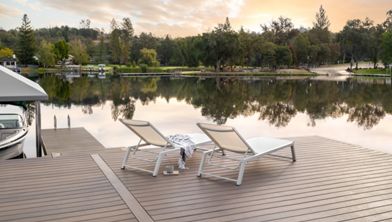How to Choose the Best Type of Joist Hanger
Learn about the different types of joist hangers to avoid costly mistakes in your deck-building process.
Joist hangers play a key structural role in making your deck sturdy and keeping it that way for decades. Discover how these modest but mighty connectors do the heavy lifting in deck safety, and how to choose the right type of hanger for your project.
What is a Joist Hanger?
A joist hanger is a steel bracket designed to be fastened to both a deck joist and a ledger board. Its primary purpose is to create strong mechanical connections between the joists and the ledger board, and sometimes between the joists and rim joist (more on this below).
Joist hangers strengthen a deck so it can withstand heavy loads and the forces of wind and seismic activity. The term “hanger” reflects its function as a means of support that allows a joist to be suspended in place, sometimes without even coming in direct contact with the surface of a ledger board. Joist hangers are available in a variety of sizes and configurations at home centers, lumberyards, and specialty decking suppliers.
Types of Joist Hangers
Dozens of types of joist hangers are available, but these are the most popular hangers for decks:
- Face Mount, the most common type, will work in most situations and for most common lumber sizes.
- Concealed/Inverted Flange joist hangers work well for joists located at the end of the ledger board or rim joist where there’s no space to fasten the flanges on both sides of a joist. These hangers need to be installed before the joists.
- Skewed hangers are designed for joists that are attached to a ledger board or rim joist at an angle. Left- and right-skewed hangers are commonly available in 45-deg. angle configurations.
- Double joist hangers are used to secure two joists that have been sandwiched together (often to create a beam). Triple-wide hangers and wider are also available but will likely be a special-order item at retailers.
- Angle Brackets are basically single-flange hangers. They can sometimes be used on the end joists in place of an inverted flange hanger.
- Stair Stringer Hangers might not technically be considered joist hangers, but they serve a similar function for stair stringers.
- Decorative joist hangers might be a good choice if the space below the deck includes a gathering space and the framing above is conspicuous.
Are all joist hangers suitable for decks?
The short answer is no. Most deck hardware has a galvanized zinc coating that prevents rust and protects against the corrosive chemicals used in pressure-treated lumber. There are varying levels of protection. Some galvanized hangers are labeled “weather resistant” but aren’t designed for outdoor use and aren’t compatible with treated lumber. These galvanized coatings are designed to protect the hangers while they’re exposed during construction. Check the label or the product information online, and choose a joist hanger that’s approved for outdoor use and compatible with treated lumber.
When in doubt, call the manufacturer. Simpson Strong Tie, a leading manufacturer of joist hangers has an excellent customer service department that can answer your questions. Even hangers with the highest level of galvanized protection may not be able to withstand the extreme corrosiveness of salty air. If you’re building a deck near the ocean, choose stainless steel hangers and hardware for the highest level of protection.
What is the Best Joist Hanger Size?
The size of the wood joists you need for your deck depends on the load the deck will have to support, and the length the joists will have to span. The heavier the load (people, furniture, snow, hot tubs, etc.) and the longer the distance the joists need to span, the larger the joists need to be. Most joist hangers will be clearly labeled with the size of the joist they are made for: 2x6, 2x8, 2x10, etc.
The side flanges on a face-mount joist hanger will be just shorter than the height of the joist. Never use hangers designed for joists that are smaller than the joists you install. Conversely, never use hangers larger than the joists you install. The side flanges on oversized hangers will stick up past the top of the joists and interfere with the decking. And any alteration of the hangers (such as trimming off the tops) will render them non-code-compliant.
Most joist hangers are designed to accommodate the thickness of standard “nominal” lumber, the thickness of which is misleading. For example, a 2x10 joist is actually 1-1/2 in. thick, not 2 in. Some hangers are designed for engineered lumber and rough-cut lumber, which have different thicknesses than standard/nominal lumber. Double-check the width of the hangers you choose, and look for hangers labeled “Nominal Lumber.”
When it comes to metal thickness, you will likely come across two options, 18 gauge and 20 gauge. Deck safety can’t be overvalued, so always play it safe and choose 18-gauge hangers (18-gauge is thicker than 20). And always consult your local building official—it’s far easier to confirm your choice of hangers up front than to replace inadequate hardware after you fail a building inspection. Again, when in doubt, call the manufacturer.
In case you were wondering: The numbering system for metal thickness may seem counterintuitive because it works in reverse: The higher the gauge number, the thinner the metal. This is a historical quirk originating from the manufacturing process of metal sheeting and wire. The gauge number originally referred to the number of times a piece of metal had to be run through a rolling mill to reach a specific thickness. Thinner metal required more passes through the mill, so it carried a higher number.
The Best Fasteners to Use on Joist Hangers
Simply stated, the best advice is to use the fasteners that the joist hanger manufacturer recommends. Check the labels of the hangers or online product descriptions. If that info isn’t available, here are some guidelines:
- Both screws and nails are usually acceptable.
- Use the same type of metal: galvanized fasteners with galvanized hangers and stainless steel fasteners with stainless steel hangers.
- Basic rule of thumb: Use 1-1/2-in. fasteners on the flanges that go directly into the ledger, and drive 3-in. fasteners in at an angle through the joist and into the ledger.
- Longer is not necessarily better: When you’re attaching hangers to a rim joist, you don’t want the fasteners to protrude out the other side of the board.
How much do joist hangers cost?
Eighteen-gauge, face-mount joist hangers designed for use with 2x6 up to 2x10 treated lumber cost $2 to $3 each. For stainless steel, decorative, and other specialty hangers, the price jumps to $13 or more. Many retailers offer a discount for buying hangers in bulk (25 or more).
Install hangers or joists first?
You can install joist hangers on the ledger or rim board before you install the joists, or you can install the joists first and install the hangers around them. Which is best? Here are some pros and cons of each:
Hangers first:
PROS:
- Hangers are easier to fasten to a ledger without the joist in the way.
- The hangers support the joist when you install them, which is helpful, especially if you’re working alone.
- Preinstalled hangers help straighten twisted joists when you drop them into place.
CONS:
- Gaps between the ledger and joists can be harder to detect and may go unnoticed.
- When the hangers are set at the same height along the ledger, the variation in joist height (commonly 3/8 in. or more) could result in an uneven top and wavy decking.
Joists first:
PROS:
- It’s easier to account for variation in joist lumber height (to achieve a flat top service) when you install the joists first.
- Any gaps between the ledger and joist can be easily seen and corrected before you install the hangers.
CONS:
- Toenailing joists to ledger boards can be difficult, especially when you’re working alone or working with twisted lumber.
If you don’t sink the nails flush with the surface, the protruding nail heads could prevent the hangers from pressing up tight against the sides of the joists.
Joist hanger installation tips
- Avoid gaps of more than 1/8 in. between joists and ledgers/rim boards.
- Hangers with inverted flanges will create a space between the joists and the ledger or rim boards. Trim the joists hung with inverted-flange hangers so they align with the adjacent joists that are supported with face-mount hangers.
- Hammer in the speed prongs to set the hanger in place before you add the fasteners.
- When you set the hangers first:
- When the top of a joist ends up too high, shave off a small amount of wood from the part of the joist that rests in the seat of the hanger.
- When the top of a joist is too low, attach a composite shim under the joist to raise it. Hold the shim in place with a dab of adhesive or nail.
- When you install joists first, sink the heads of the nails flush.
- Pro deck builders often use nail guns with probe tips, which greatly speeds up the installation process.
Lay out the joist location on the ledger board before you install it, so you can avoid having those large ledger fasteners interfere with the joist hangers.
For more helpful deck building information, check out these how-to videos from Trex Academy:
How to Install a Deck Ledger Board and Attach Flashing
This content was partially or fully generated by AI and has been reviewed by our team to ensure accuracy and relevance.






































